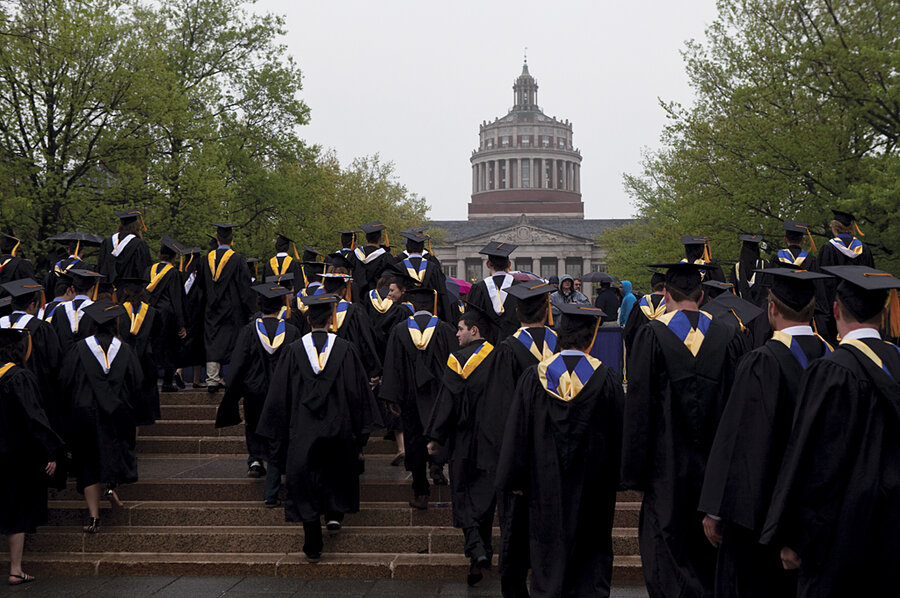Big squeeze for grads: Student loans rise, job opportunities dim
Loading...
| New York
After losing a retail job in 2009, David Corgan of Coon Rapids, Minn., went to college to boost his job prospects. Now in his mid-30s, the third-year student at a local community college faces the prospect of $35,000 in student debt once he finishes up, he hopes, at the University of Minnesota.
"It's terrifying," says Mr. Corgan, who is majoring in astrophysics. "I know I can repay the debt. But whether it will improve my job prospects, that's hard to judge."
Granted, a job in astrophysics may be harder to land than, say, one in retail sales. Still, the squeeze Corgan is feeling is increasingly common among college students and graduates in many majors. On one side, the costs of tuition have been rising steadily, even as grant programs fail to keep pace with them. On the other side, job opportunities are scarce. Finding good-paying jobs to repay those student loans has become a tall order. As of July, 13 percent of college grads ages 20 to 24 were unemployed.
The squeeze could intensify if policymakers, now tackling the federal deficit, trim education subsidies beyond the cuts already made. Already, students' growing debt burden threatens their ability to spend as young adults and contribute to the economy. If high school grads forgo higher education because its costs appear to outweigh its advantages, the nation's long-term competitiveness will likely suffer.
"The situation is bad, really bad, and getting worse," says Rich Williams, higher education advocate at the U.S. Public Interest Research Group in Washington, D.C. "About 10 to 15 years ago, only about one-third of students needed to borrow money to graduate" from college, "and borrowers needed only about $12,000" on average, he says. Today, some two-thirds of college students need loans. Their average borrowing exceeds $27,000, says Mark Kantrowitz, publisher of FinAid.org and Fastweb.com.
Last year, student-loan debt surpassed US credit-card debt. By January, says Mr. Kantrowitz, it's expected to hit $1 trillion. To be sure, the default rate on federal student loans – at 8.8 percent in the 2009 fiscal year, according to the Department of Education – is still below double-digit levels. Also, a number of forbearance and debt repayment programs help former students manage loan repayments.
Debt loads are "troubling for some students, but for the vast majority of students they are not a problem," says Donald Heller, education professor at The Pennsylvania State University in University Park. "But if the economy doesn't improve in two to three years, student debt could become a much greater problem for the nation."
Annabel Pollioni, one of eight children of a financially struggling family, expects to graduate from Rutgers University in New Brunswick, N.J., with a political science degree and $34,000 of student debt (counting borrowing at a previous college). The college senior is planning for a career working for nonprofit organizations. This would lead to her goal – to run for US president – and help qualify her for federal student loan forgiveness.
Ms. Pollioni considers herself to be among the luckier students and believes her student debt will be manageable. But to her, the debt problem nationally is "out of control." For many such borrowers, repayment will be a long ordeal.
"If your debt at graduation is less than your job's starting salary, you can repay the debt in 10 years," says Kantrowitz of FinAid.org, based in Cranberry Township, Pa. "But if you've needed to borrow more than that, a repayment plan could stretch the loan out 20 years. About one-third of this year's college grads are in that situation: They'll be paying back student loans when their children are ready for college."
Political developments could make matters worse. One of the few specific budget cuts put into this summer's compromise over the national debt limit involved college loans. Starting next July, the US government will no longer subsidize interest on federal Stafford loans for graduate and professional students, making the loans costlier for some students. Another change: As of next July, incentives for repaying federal student loans on time will largely disappear for both graduates and undergraduates.
This fall, the congressional "super committee" charged with finding an additional $1.5 trillion of spending cuts over 10 years could further nip at education. Some items that the committee might at least weigh, some experts suggest:
•Tightening some qualifications for federal Pell student aid grants.
•Removing interest rate subsidies needy undergraduates get (which keeps interest from accruing until students begin repaying their loans).
•Eliminating some educational tax credits.
How much worse could the super committee make things for students? "Every dollar in grants that gets cut likely translates into about $1 in [student] debt," estimates Kantrowitz.
Steeper loan repayments could have a broader economic impact, eating into the discretionary spending of indebted graduates just when they'd otherwise be opening up wallets for everything from homes to baby clothes.
And at some point, national competitiveness could be hurt. Those who "have trouble repaying loans can send signals to other students to pursue less education," points out Cristian deRitis, a director in the West Chester, Pa., office of Moody's Analytics. "That would have a broad economic impact" since "our economy needs an educated workforce to grow and be internationally competitive."





